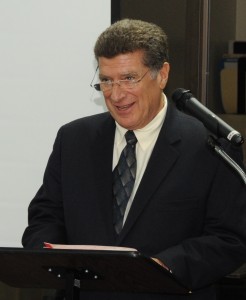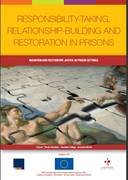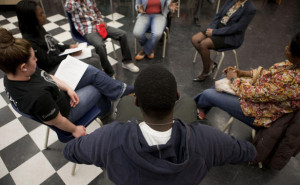News & Announcements
- Details
- Written by Joshua Wachtel
 This summer IIRP president Ted Wachtel will be attending and presenting at three major conferences.
This summer IIRP president Ted Wachtel will be attending and presenting at three major conferences.
First, in Helsinki, Finland he'll be presenting at the 7th European Forum on Restorative Justice. This year's theme is "Connecting people - Linking Victims, Offenders and Community." Wachtel's presentation is titled "Improving School Climate Through Restorative Practices," and time will be made for questions and answers, as well. The conference runs June 14 to 16, 2012, and more information about it can be found here.
- Details
- Written by Joshua Wachtel
 MEREPS – Mediation and Restorative Justice in Prison Settings – was a three-year project funded by the EU. Their final publication (edited by Barabás, T., Fellegi, B. & Windt, Sz.) is now freely downloadable here.
MEREPS – Mediation and Restorative Justice in Prison Settings – was a three-year project funded by the EU. Their final publication (edited by Barabás, T., Fellegi, B. & Windt, Sz.) is now freely downloadable here.
The pilot project tested the applicability of the restorative justice (RJ) approach in the Hungarian prison system. It focused on two key practical questions:
- How can practices representing restorative principles be introduced in prison settings?
- What are the institutional, legal and personal conditions that serve as supportive circumstances, and what are the specific challenging circumstances?
- Details
- Written by Alia Sheety
In reviewing the movie “Salmon Fishing in the Yemen” on April 14 Miranda Cashin in The Chronicle wrote, “If you are not a fisherman, it’s hard to get excited about fishing… But it is more than just a film about fishing… It is a tale of faith, of hope about reaching for a dream and clinging onto it despite all odds.”
 For me, as a restorative practitioner, watching that movie there was indeed more than fishing… and even more than reaching for a dream… for me it is about restoratively reaching a dream while at the same time truly dealing with, and reducing, the odds.
For me, as a restorative practitioner, watching that movie there was indeed more than fishing… and even more than reaching for a dream… for me it is about restoratively reaching a dream while at the same time truly dealing with, and reducing, the odds.
- Details
- Written by Joshua Wachtel
 Flickr Creative Commons © Jerry BunkersHere's a letter to the editor in the Des Moines Register which concisely articulates the essence of restorative justice and restorative practices:
Flickr Creative Commons © Jerry BunkersHere's a letter to the editor in the Des Moines Register which concisely articulates the essence of restorative justice and restorative practices:
In his story of restorative justice (“Growing Past Hate”, April 22) Fred Van Liew shares a poignant example of how rethinking responses to wrongdoing can benefit everyone. He wonders why we aren’t routinely using these approaches in our community.
- Details
- Written by Joshua Wachtel
 Photo by Matthew Sherwood for the Toronto StarCatherine Porter has a great column on the front page of the Toronto Star the other day, the city's highest circulation newspaper which also circulates throughout Canada. The piece opens with a moving anecdote:
Photo by Matthew Sherwood for the Toronto StarCatherine Porter has a great column on the front page of the Toronto Star the other day, the city's highest circulation newspaper which also circulates throughout Canada. The piece opens with a moving anecdote:
A week ago, two friends at Weston Collegiate Institute had an argument.
One was a slip of a boy in Grade 9, his plaid shirt buttoned right to the Adam’s apple. The other was an 18-year-old giant — literally 6-foot-8 — with ear buds and a hoodie.
- Details
- Written by Joshua Wachtel
 Inquirer staff celebrate their Pulitzer Prize for public service. (MICHAEL BRYANT / Inquirer Staff Photographer)The Philadelphia Inquirer has won a Pulitzer Prize for its seven-part series last year, "Assault on Learning." The article "revealed that violence in city schools was widespread and underreported, with 30,000 serious incidents over the last five school years. Those findings were later corroborated by a Philadelphia School District panel on safety, spurred an overhaul of incident reporting in the district, and prompted hiring of a state-funded safe-schools advocate." (See "Inquirer wins Pulitzer Prize for school violence series" by Inquirer staff writer Mike Armstrong.)
Inquirer staff celebrate their Pulitzer Prize for public service. (MICHAEL BRYANT / Inquirer Staff Photographer)The Philadelphia Inquirer has won a Pulitzer Prize for its seven-part series last year, "Assault on Learning." The article "revealed that violence in city schools was widespread and underreported, with 30,000 serious incidents over the last five school years. Those findings were later corroborated by a Philadelphia School District panel on safety, spurred an overhaul of incident reporting in the district, and prompted hiring of a state-funded safe-schools advocate." (See "Inquirer wins Pulitzer Prize for school violence series" by Inquirer staff writer Mike Armstrong.)
In part 6 of the series, "Some Antiviolence Efforts Are Working," staff writers discussed restorative practices quote John Bailie, IIRP's Director of Continuing Education:
- Details
- Written by Joshua Wachtel
 Van Brunt Elementary and Middle School Faculty"There are no bullies in Horicon, only students who have made bad choices. Taking a positive and proactive approach to improve the school environment, the Horicon Van Brunt Elementary and Middle School has changed its approach when responding to students who have made bad choices--and reduced disciplinary referrals by over 60 percent since 2009."
Van Brunt Elementary and Middle School Faculty"There are no bullies in Horicon, only students who have made bad choices. Taking a positive and proactive approach to improve the school environment, the Horicon Van Brunt Elementary and Middle School has changed its approach when responding to students who have made bad choices--and reduced disciplinary referrals by over 60 percent since 2009."
This is the lead in of an article co-authored by Robert D. Rettmann and Patrice Vossekuil, IIRP's Wisconsin affiliate. The article originally appeared in the Journal of Safe Management of Disruptive and Assaultive Behavior in March, 2012. In it the authors discuss the use of restorative circles as well as a unique playground program:
- Details
- Written by Joshua Wachtel
Philadelphia, Pennsylvania public school students have launched the "Safe to Count on Me Campaign." Their kickoff rally is scheduled for 3pm on April 25, 2012 at Norris Square Park (Howard & Diamond Streets) in Philadelphia. Confirmed guests speakers include:
· Mayor of Philadelphia, Michael Nutter
· Councilwoman Maria Quiñones-Sánchez
· State Representative Tony Payton
· Student Advocates from Youth United For Change
- Details
- Written by Joshua Wachtel
Helping, fixing and serving represent three different ways of seeing life. When you help, you see life as weak. When you fix, you see life as broken. When you serve, you see life as whole. Fixing and helping may be the work of the ego, and service the work of the soul.
Read the rest of this insightful article here: DailyGood: Helping, Fixing or Serving?, by Rachel Naomi Remen, MD.
To discuss: Is this another way of saying, "not to or for, but with"?
Please respond in the comments section.
- Details
- Written by Joshua Wachtel
Here's a clip from an article by Martin Howard that appeared at Restorative Justice Online's blog. The Sycamore Tree Project connects victims of crime with offenders in prisons.
"I've never seen a program change people like this one."
I've heard this from a prison psychologist and a prison manager, who are more familiar with the failures of the typical group therapy sessions. What they notice during STP is a change in the empathy level of the inmates. And they are stunned by the positive chemistry that is created within the group.

Restorative Works Year in Review 2023 (PDF)
All our donors are acknowledged annually in Restorative Works.

